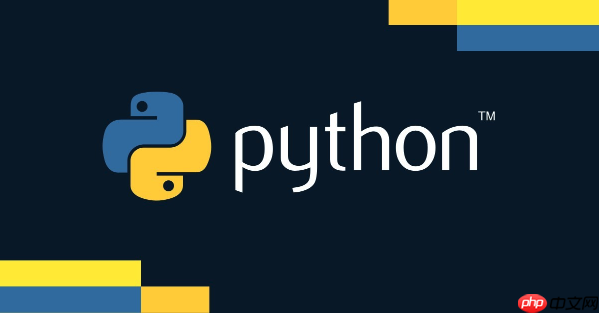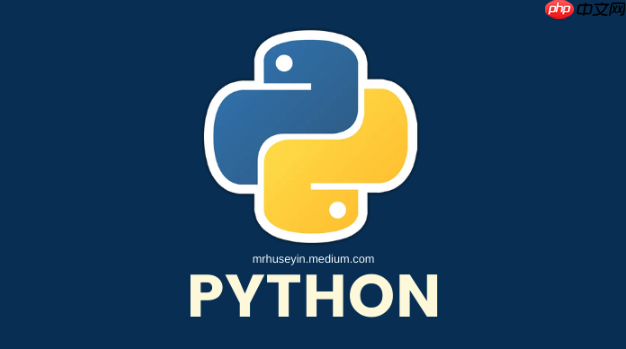在python中優(yōu)化循環(huán)性能的關(guān)鍵是利用numpy的向量化運算以避免顯式循環(huán)。1. 使用numpy向量化操作替代for循環(huán),顯著提升處理效率;2. 利用廣播機制實現(xiàn)不同形狀數(shù)組的高效運算;3. 選擇合適的通用函數(shù)(ufunc)和內(nèi)置聚合函數(shù)提高計算效率;4. 避免不必要的數(shù)組復(fù)制,優(yōu)先使用原地操作減少內(nèi)存開銷;5. 合理選擇數(shù)據(jù)類型、使用視圖而非副本、結(jié)合生成器或memmap處理大數(shù)據(jù)集以優(yōu)化內(nèi)存使用。通過這些方法可有效提升代碼性能與內(nèi)存管理效率。

在python中,優(yōu)化循環(huán)性能的關(guān)鍵在于盡可能避免顯式循環(huán),并利用NumPy的向量化運算能力。NumPy允許你對整個數(shù)組執(zhí)行操作,而不是逐個元素進(jìn)行處理,這通常能帶來顯著的性能提升。

解決方案:

-
理解循環(huán)的瓶頸: 首先,要明白Python的for循環(huán)本身效率并不高,尤其是在處理大量數(shù)據(jù)時。這是因為Python是解釋型語言,每次循環(huán)迭代都需要解釋器執(zhí)行額外的開銷。
立即學(xué)習(xí)“Python免費學(xué)習(xí)筆記(深入)”;
-
NumPy向量化: NumPy的核心優(yōu)勢在于其向量化運算。這意味著你可以直接對整個NumPy數(shù)組執(zhí)行操作,而無需編寫顯式循環(huán)。例如,將兩個數(shù)組相加:

import numpy as np # 使用循環(huán) def add_lists(list1, list2): result = [] for i in range(len(list1)): result.append(list1[i] + list2[i]) return result # 使用NumPy向量化 def add_Arrays(array1, array2): return array1 + array2 list1 = [i for i in range(1000)] list2 = [i for i in range(1000)] array1 = np.array(list1) array2 = np.array(list2) # 性能測試 import time start_time = time.time() add_lists(list1, list2) print(f"循環(huán)耗時: {time.time() - start_time} 秒") start_time = time.time() add_arrays(array1, array2) print(f"NumPy耗時: {time.time() - start_time} 秒")
你會發(fā)現(xiàn),NumPy的向量化版本比循環(huán)版本快得多。
-
廣播機制: NumPy的廣播(broadcasting)機制允許不同形狀的數(shù)組進(jìn)行運算。例如,你可以將一個標(biāo)量加到一個數(shù)組的所有元素上,而無需顯式循環(huán)。
array = np.array([1, 2, 3]) scalar = 2 result = array + scalar # 廣播機制 print(result) # 輸出: [3 4 5]
-
通用函數(shù)(ufunc): NumPy提供了許多通用函數(shù)(ufunc),這些函數(shù)可以對NumPy數(shù)組進(jìn)行元素級別的操作。ufunc通常是用c語言實現(xiàn)的,因此速度非常快。
array = np.array([1, 2, 3]) result = np.sin(array) # 使用sin函數(shù) print(result)
-
避免不必要的數(shù)組復(fù)制: NumPy的一些操作會創(chuàng)建新的數(shù)組,這可能會導(dǎo)致額外的內(nèi)存開銷。盡量使用原地操作(in-place operations)來修改數(shù)組,例如 array += 1 而不是 array = array + 1。
-
使用NumPy內(nèi)置函數(shù): 盡量使用NumPy提供的內(nèi)置函數(shù),例如 np.sum(),np.mean(),np.max() 等。這些函數(shù)通常比自己編寫的循環(huán)更有效率。
-
注意數(shù)據(jù)類型: 確保NumPy數(shù)組的數(shù)據(jù)類型與你的計算需求相匹配。例如,如果你的數(shù)據(jù)是整數(shù),使用 np.int32 或 np.int64,而不是 np.float64。
如何選擇合適的numpy函數(shù)進(jìn)行向量化?
選擇合適的NumPy函數(shù)進(jìn)行向量化,需要理解NumPy函數(shù)的功能和適用場景。 核心是尋找能夠直接對整個數(shù)組或數(shù)組的特定維度進(jìn)行操作的函數(shù),而不是需要逐個元素處理的函數(shù)。
-
算術(shù)運算: NumPy提供了基本的算術(shù)運算符的向量化版本,如 +(加法), -(減法), *(乘法), /(除法), **(冪運算)。
a = np.array([1, 2, 3]) b = np.array([4, 5, 6]) c = a + b # 向量加法 print(c) # 輸出: [5 7 9]
-
比較運算: NumPy也支持比較運算符的向量化,如 ==(等于), !=(不等于), >(大于), =(大于等于),
a = np.array([1, 2, 3]) b = np.array([2, 2, 4]) c = a == b # 向量比較 print(c) # 輸出: [False True False]
-
邏輯運算: 可以使用 np.logical_and(), np.logical_or(), np.logical_not() 等函數(shù)進(jìn)行邏輯運算。
a = np.array([True, False, True]) b = np.array([False, True, False]) c = np.logical_and(a, b) print(c) # 輸出: [False False False]
-
數(shù)學(xué)函數(shù): NumPy提供了大量的數(shù)學(xué)函數(shù),如 np.sin(), np.cos(), np.exp(), np.log(), np.sqrt() 等。
a = np.array([0, np.pi/2, np.pi]) b = np.sin(a) print(b) # 輸出: [0.000e+00 1.000e+00 1.225e-16]
-
聚合函數(shù): NumPy提供了各種聚合函數(shù),用于計算數(shù)組的統(tǒng)計信息,如 np.sum(), np.mean(), np.max(), np.min(), np.std(), np.var() 等。
a = np.array([1, 2, 3, 4, 5]) s = np.sum(a) print(s) # 輸出: 15
-
條件函數(shù): np.where() 函數(shù)可以根據(jù)條件選擇數(shù)組中的元素。
a = np.array([1, 2, 3, 4, 5]) b = np.where(a > 2, a, 0) # 如果a中的元素大于2,則保留,否則替換為0 print(b) # 輸出: [0 0 3 4 5]
如何避免NumPy向量化中的內(nèi)存陷阱?
NumPy向量化雖然能顯著提高性能,但如果不注意,也可能導(dǎo)致內(nèi)存問題。 核心在于理解NumPy如何處理數(shù)組,并采取措施避免不必要的內(nèi)存分配和復(fù)制。
-
原地操作: 盡量使用原地操作符,如 +=, -=, *=, /=, 來修改數(shù)組。 避免使用 a = a + b 這樣的語句,因為它會創(chuàng)建一個新的數(shù)組來存儲結(jié)果,而原地操作符會直接修改原始數(shù)組。
a = np.array([1, 2, 3]) a += 1 # 原地加法 print(a) # 輸出: [2 3 4]
-
避免不必要的復(fù)制: NumPy的一些操作會創(chuàng)建數(shù)組的副本。 例如,切片操作 a[1:3] 會創(chuàng)建一個新的數(shù)組,指向原始數(shù)組的一部分?jǐn)?shù)據(jù)。 如果你需要修改切片,并且不希望影響原始數(shù)組,那么復(fù)制是必要的。 但是,如果不需要修改原始數(shù)組,可以使用 view() 方法創(chuàng)建一個視圖,它與原始數(shù)組共享數(shù)據(jù)。
a = np.array([1, 2, 3, 4, 5]) b = a[1:3] # 創(chuàng)建副本 c = a[1:3].view() # 創(chuàng)建視圖 b[:] = 0 # 修改副本,不影響a c[:] = 10 # 修改視圖,會影響a print(a) # 輸出: [ 1 10 10 4 5] print(b) # 輸出: [0 0] print(c) # 輸出: [10 10]
-
合理選擇數(shù)據(jù)類型: 選擇合適的數(shù)據(jù)類型可以減少內(nèi)存占用。 例如,如果你的數(shù)據(jù)是整數(shù),并且范圍不大,可以使用 np.int8 或 np.int16,而不是 np.int64。
-
使用生成器或迭代器: 如果你需要處理的數(shù)據(jù)量非常大,無法一次性加載到內(nèi)存中,可以使用生成器或迭代器來逐塊處理數(shù)據(jù)。 NumPy提供了 np.fromiter() 函數(shù),可以從迭代器中創(chuàng)建數(shù)組。
def my_generator(n): for i in range(n): yield i a = np.fromiter(my_generator(10), dtype=np.int32) print(a) # 輸出: [0 1 2 3 4 5 6 7 8 9]
-
使用 numpy.memmap: 對于非常大的數(shù)據(jù)集,可以考慮使用 numpy.memmap,它允許你將數(shù)組存儲在磁盤上,并像訪問內(nèi)存中的數(shù)組一樣訪問它。 這可以避免將整個數(shù)據(jù)集加載到內(nèi)存中。
# 創(chuàng)建一個memmap數(shù)組 filename = "data.dat" dtype = np.float32 shape = (1000, 1000) fp = np.memmap(filename, dtype=dtype, shape=shape, mode='w+') # 寫入數(shù)據(jù) fp[:] = np.random.rand(*shape) # 清空緩存,確保數(shù)據(jù)寫入磁盤 fp.flush() # 從磁盤讀取數(shù)據(jù) fp_read = np.memmap(filename, dtype=dtype, shape=shape, mode='r') # 訪問數(shù)據(jù) print(fp_read[0, 0])
-
避免中間數(shù)組: 盡量避免創(chuàng)建不必要的中間數(shù)組。 例如,如果你需要對一個數(shù)組進(jìn)行多個操作,可以將這些操作合并到一個表達(dá)式中,而不是創(chuàng)建多個中間數(shù)組。
-
使用 numpy.einsum: 對于復(fù)雜的數(shù)組操作,可以嘗試使用 numpy.einsum 函數(shù),它可以有效地執(zhí)行各種張量操作,并減少內(nèi)存占用。
a = np.array([[1, 2], [3, 4]]) b = np.array([[5, 6], [7, 8]]) # 計算矩陣乘法 c = np.einsum('ij,jk->ik', a, b) print(c)
通過以上方法,可以有效地避免NumPy向量化中的內(nèi)存陷阱,并充分利用NumPy的性能優(yōu)勢。

















